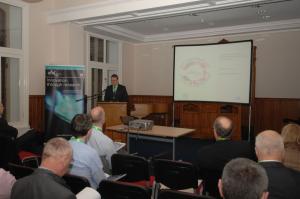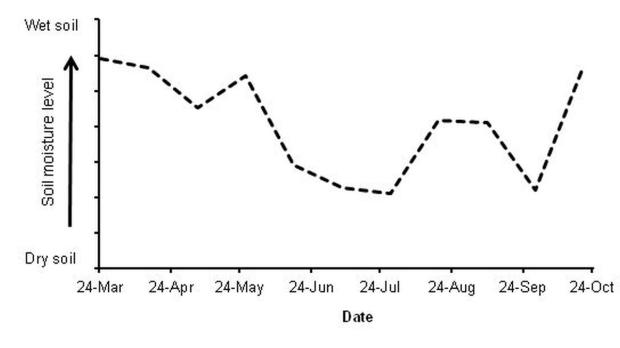GrassCheck 2014: floods of autumn grass, then autumn floods!
Date published:
Whilst most grazing livestock were enjoying plentiful supplies of high quality grass and near perfect grazing conditions in early October, a period of very wet weather during early November brought the grazing season on most farms to an abrupt end. The 2014 growing season will be remembered as a very good grass year following a number of difficult seasons. However, as always, there were a few challenges during the year, most notably during the main harvest window for first cut silage. Once again details of grass growth through the season were recorded and highlighted within the DARD and AgriSearch funded GrassCheck project. The data presented in Figure 1 summarise how grass growth during 2014 compared with average growth during the past seven years (2007 to 2013).

Spring
The 2014 growing season began slowly, with growth below average throughout March and April. In addition, grazing conditions were challenging in many areas as shown by the relatively high soil moisture levels recorded at the GrassCheck sites in March and April (Figure 2). However, growth rates continued to increase, and by mid-May growth was higher than the long term average, with growth at individual sites exceeding 100 kg dry matter per hectare per day at this time. While this provided a welcome boost to first cut silage yields, the unsettled weather during mid and late May resulted in a delay in harvesting, which has had a negative impact on the quality of silage available this winter.
Mid-season
The weather turned more settled into June and through July, and this is reflected in the decreasing soil moisture levels in Figure 2. However, following the normal post-peak ‘dip’ in growth, grass growth rates surged again in mid June/early July, with growth again exceeding 100 kg dry matter per hectare per day at some of the GrassCheck sites. Grazing conditions were excellent at this time, and grass utilisation efficiency was high on many farms. However, grass growth dipped below average in mid-July as soil moisture levels fell rapidly, with a ‘moisture deficit’ restricting growth. However, heavy showers in early August quickly removed the restriction of soil moisture on most farms, with 106 mm (4 inches) of rain recorded at Hillsborough during the first week of August, compared with a total of 111 mm throughout June and July.

Autumn
The arrival of settled and warm weather in early September was a welcome relief, and growth responded to the high temperatures, reaching highs of 50 to 60 kg dry matter per hectare per day, double the seasonal norm for late September. This settled and mild theme remained the main talking point of the weather throughout September and October, with growth remaining above average throughout this period. September was exceptionally dry, with only 4.4 mm of rain recorded at Hillsborough. As a result grass supplies were generally good on most farms going into October and grazing conditions were excellent. However, heavy and thundery downpours throughout October, and particularly during late October and early November, quickly increased soil moisture content and made grazing conditions difficult and eventually impossible on many farms. Despite this abrupt end, 2014 in general provided ideal grazing conditions for extended periods, and an ideal opportunity for extended grazing well into October.
2014 annual production
Despite the slow start to growth in spring, excellent growing conditions on all but the driest soils throughout much of the main growing season and into autumn resulted in above average annual yields for 2014. For example, while the long term average annual yield of grass grown within the GrassCheck project is 11.0 tonnes dry matter per hectare, the annual dry matter yield across the four sites during 2014 was 11.7 tonnes dry matter per hectare, with individual sites producing in excess of 13.0 tonnes dry matter per hectare. Note that these yields are based on an annual N fertiliser use of 270 kg/ha.
Summary
Whilst 2014 provided some ideal growing and grazing conditions, there were occasions when grassland managers had to react to specific challenges, notably in managing periods of exceptionally high growth rates and high grass supplies in early autumn. An understanding of grass growth and grass supply is an essential skill in ensuring the correct grassland decisions are made in a timely manner, and vital if grass quality and subsequently animal performance from grazed grass is to be optimised. The AgriSearch and DARD funded GrassCheck project provides this information on a weekly basis throughout the grazing season, and the project will return in spring to again provide the information that is essential to meet whatever challenges the 2015 grazing season brings.
by Andrew Dale (AFBI Hillsborough) and Norman Weatherup (CAFRE, Greenmount Campus)
Notes to editors:
AFBI carries out high-quality technology research and development, statutory, analytical, and diagnostic testing functions for DARD and other Government departments, public bodies and commercial companies. AFBI's Vision is “Scientific excellence in Northern Ireland … serving the world”.All media enquiries to AFBI Press Office 028 9025 5326.